For my opening article I wanted to discuss a subject relevant to anyone who enjoys espresso, and maybe debunk a few myths in the process. I’ve only been a barista for about three years, starting off in the industry retailing domestic machines in a department store and somehow ending up head of training for a machine manufacturer in the UK.
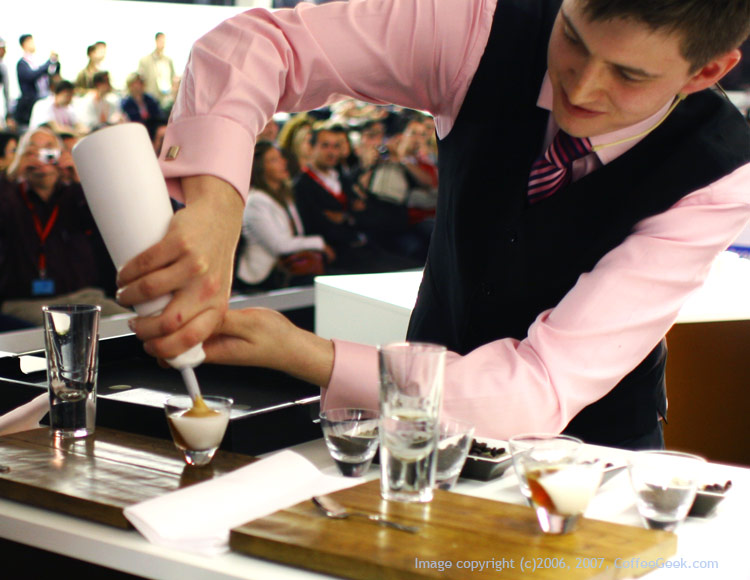
Early on in my involvement in espresso, I realised that a lot of people around the world were spending a lot of time and money researching coffee, but I also realised that very few people who were actually brewing and serving the stuff were reading the fruits of the researchers’ efforts. In short course I became slightly obsessed with food science, going above and beyond espresso and coffee, and I hope this column is one way to spread the word about not only my own thoughts on espresso and the preparation of the beverage, but also the words and deeds of many of these researchers.
This obsession of mine became part of my signature when it came to barista competitions. This doesn’t mean that everything I am going to write will be from a scientific point of view – while this article is about crema – I plan to cover all aspects of being a barista from competitions (both individual and team) through to the changing landscape and challenges of the shop barista. With this article in particular I want to present information as best as I have been able to discover. I am not going to claim to be absolutely right and I hope each article I write fosters healthy debate on the subject discussed.
When I started down the path towards great espresso, away from the bitter, everyday awful coffee that surrounds me, crema became something of a grail. Whether shopping for a good shot or taking the process into the home, first and foremost we want to see an espresso topped with a thick, dense and red brown foam.
The first reliable delivery of espresso featuring crema in a commercial bar is usually credited to Achille Gaggia, the first Italian machine designer to provide a viable, working high pressure machine to the marketplace. Indeed, if you look at all the pre-WW2 espresso advertising, like the classic images of Victoria Arduino, you’ll notice all the espressos are crema-less, black shots. Gaggia’s “Crema Naturale” machine, operated by spring piston, changed all of this for the mainstream espresso drinker, but by no means was he the first.
Today, no definition of a good espresso could be made without mentioning crema and if we look to a company that has become one of the industry standard setters in many ways – Illycaffe – they do not disappoint:
“Italian espresso is a polyphasic beverage, prepared from roast and ground coffee and water alone, constituted by a foam layer of small bubbles with a particular tiger-tail pattern, on top of an emulsion of microscopic oil droplets in an aqueous solution of sugars, acids, protein-like material and caffeine, with dispersed gas bubbles and solids.’
What is Crema and Why Does it Appear?
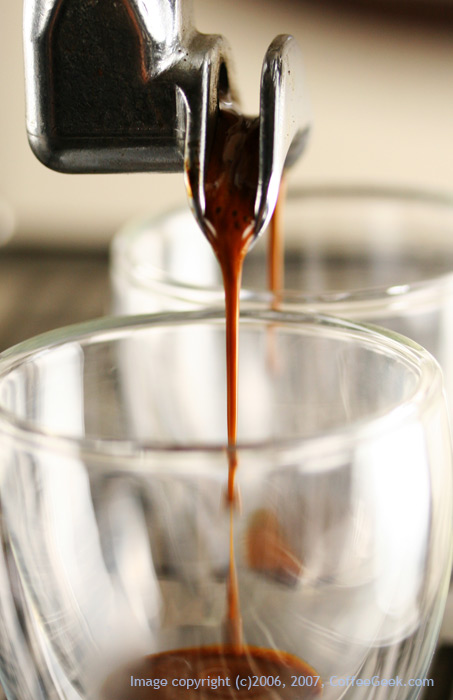
Amidst the complex chemistry of coffee roasting a lot of carbon dioxide, or CO2, is generated. Much is lost from the porous bean as it cools and rests, but a considerable quantity is retained with the cells. Grinding exposes a good amount of the remaining CO2, so as short a wait before brewing as possible is necessary to take advantage of this gas and its many beneficial properties.
Hot water hits the ground coffee and interesting things start to happen. To many who talk and write about espresso, the pump pressure of 9 bars is most relevant to emulsifying the otherwise insoluble oils in the coffee. It has another use as well, because it allows water to become supersaturated with the CO2, dissolving far more than it could if the water is at normal atmospheric pressure. This is why the thousands of tiny bubbles appear as soon as the liquid escapes the pressurised basket. In the cup, these thousands of tiny bubbles settle out, much like a pint of Guinness when it is poured (where the same thing is happening, just for slightly different reasons). Hence the term the “Guinness effect”
This alone is not enough to explain the crema. After all – when I release pressure by opening a bottle of cola I briefly see bubbles rise and form a foam, but nothing that would pass the classic Italian test of supporting a spoonful of sugar. To explain this properly we have to delve briefly into a little food science.
For a foam to happen we need some bubbles and also some sort of compound or molecule that likes to wrap itself around the bubble, thus making the bubble’s structure stronger and more resilient. This chemical doing the coating is referred to as a surface active agent, or surfactant. I first came across this concept reading the Guide to Milk Frothing on CoffeeGeek, but, unlike milk where this happens via proteins, in coffee this is done by a type of compound called a melanoidin. This is a very general term for a group of compounds creating when roasting things, and scientists don’t know as much as they’d like to about them.
The reason proteins and melanoidins coat air bubbles is that parts of them are repelled by water – they are said to be hydrophobic. So rather than face water they turn and face any air, which isn’t polar, causing the whole compound to adsorb onto the bubble – and we have foam!
There is something else that is non polar and that is fat/oil. I say both because fat is just an oil in a solid state, and both solids and liquids are present. The presence of fat often destroys foam – think getting a little egg yolk in the bowl when trying to whip the whites: this fat from the yolk is the main reason so many soufflés fail.
So are the oils in coffee the reason that crema is fleeting and last only a few minutes? The simple answer is yes and no. There exists a bigger problem, and that problem is drainage. The surfactant is dissolved in the water and as gravity starts to drain the coffee from amongst the foam this can drag the coating from the bubbles and leave them weak and inelastic. Very quickly they burst and are gone.
How quickly this foam bursts is therefore linked to the speed of the drainage. The crema on top of a properly pulled shot lasts much longer than a fast shot because the liquid that makes up the entire beverage is much thicker, something confirmed by the feel in the mouth when tasting these shots.
The Colour of Crema and What it Tells Us
I mentioned the colour of crema being a reddish brown but what does it mean if the crema is more pale, or perhaps a really dark, almost burn-coloured brown? The answer partially comes from the beverage. Because crema is bubbles of CO2 covered in brewed coffee, then the darker the foam looks then the darker the brewed coffee liquid must be, one must assume.
But seeing differences in the colour of the coffee itself is extremely difficult unless you dilute two different shots down or look at them under a microscope. Another factor comes into play as well: the way that foams refract light means that the colour of the liquid foamed up will appear much lighter than the full liquid state. The smaller the bubbles are, the more exaggerated the effect can be, so the foam of even a very dark liquid that doesn’t have the same thickness as espresso will look surprisingly light (explaining why a dark pint of Guinness has a bright white, foamy head as the bubbles are extremely small and tightly packed)
In espresso, a fifteen second shot typically has a much paler crema because it is a much weaker brew. The water has had less time to capture the coffee solubles, and the resulting brew doesn’t have the same viscosity that a 25 second well prepared shot may have. For a similar reason a shot with lower temperature brew water will have pale crema because there wasn’t enough energy to dissolve everything desired from the coffee. It then makes sense that overextracted shots look darker than normal, resulting in what looks often like a burnt outer ring on the crema.
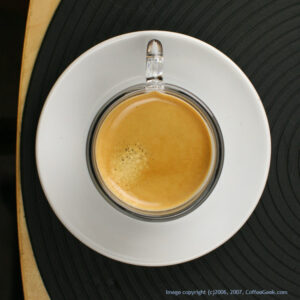
Usually the result of a weaker brew and a fast shot.
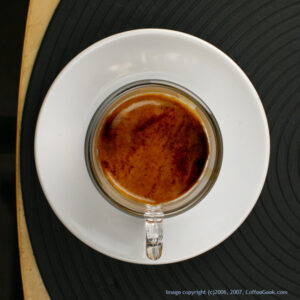
The tell-tale sign of dark outer rings and burnt appearance shows over extraction.
Can I Ever Have Too Much? A Robusta Debate
For a long time one of the counter-arguments to those who were against robusta in espresso was that some robusta gave the shot better crema. This is indeed true and the most plausible explanation is down to the oils in coffee. On average robusta varietals contain about half of the flavour and aromatic oils that arabica coffee beans typically have. This means there is less oil extracted into the brew – so less of them effectively attacking the foam and causing it to disappear. Whilst I am not going to get embroiled in the debate of whether it belongs in espresso, in effect adding robusta lowers the overall quantity of oil available to extract from your puck of coffee, meaning you have a higher probability of a stronger crema.
Food technologists will also tell you that this lower amount of oil means that whilst the shot may initially seem to have more body, the lack of oils means that sensation does not last like it does with a pure arabica shot, full of body. What is very much up for debate is the use of smaller quantities such as 5%-10% where you wouldn’t expect a dramatic loss of quality, but would expect an increase in the stability of the crema. I am happy to accept arguments that this alone cannot explain robusta’s extra crema, and there are some articles that point towards some different types of sugar in robusta that may have an effect. I hope that as more information comes to light this article can be updated and kept current.
This by no means answers every question about crema. I regularly encounter unusual espressos with unique crema producing qualities, based on their different chemical composition. One that comes to mind is a biodynamic Brazil from South Minas. The farm of Camocim dry pulps some of its Yellow Bourbon (meaning more of the sticky fruit meat is left behind when it goes for drying). In the cup it is monstrously sweet and when brewed as an espresso, even 9 days from roast, it produced huge amounts of very fluffy, oddly stiff crema.
Even as it drained and dried out, shots brewed with this Camocim, South Minas Brasil coffee showed crema that stayed strong, with a texture close to that of dry milk foam. This coffee is not alone in producing “unusual” crema. Often coffee processed very differently – such as aged coffees like Monsooned Malabar – show themselves in a crema with a different texture, be it in the dryness or perhaps brittleness of the foam.
What this all boils down to is that even within the arabica genus of coffee beans, many different varietals can have different effects on crema, and most of it is based on how the coffees store CO2, what kind of range of oils and fats they contain, and how these are extracted into the cup. The discussion about arabica vs. robusta when it comes to crema is very limiting – it can even extend to micro-genus species within the arabica family.
Tiger Flecking / Mottling
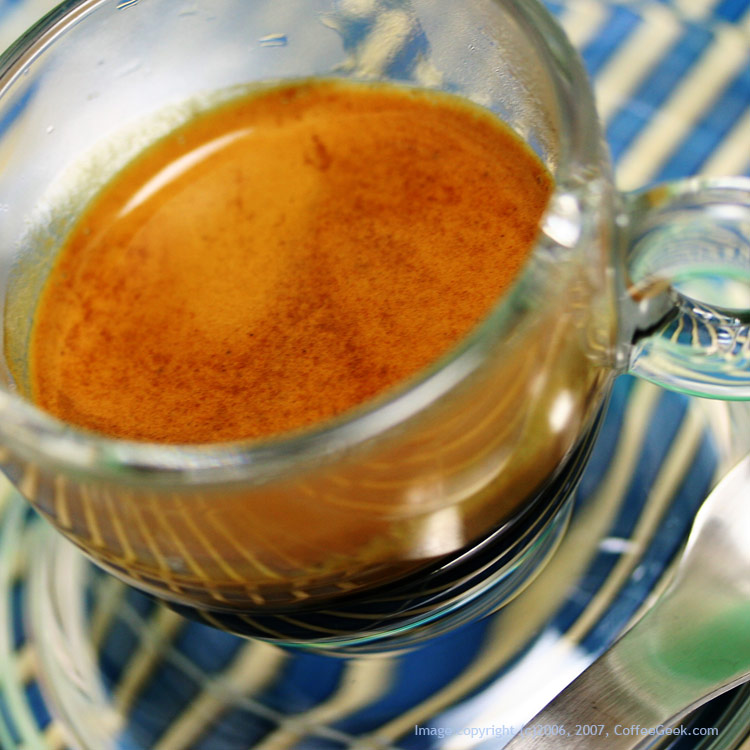
In the cup, the darker brown flecks are particles of ground coffee, showing a good extraction.
We are often told our shots should have a darkish red mottling over the surface, and Illy have made it part of their espresso definition.
The flecks are tiny fine particles of ground coffee, pushed out of the puck during the first part of the extraction. Often I see them around the rim of the shot early on and it seems to spread across the surface as the shot progresses. This would imply they are not only a sign of a good shot, but also of a good grinder that is able to produce the necessary range of particle size for good espresso.
If a grinder produces too uniform a grind then, contrary to expectation, the pieces don’t fit together as well. Imagine filling a swimming pool with beachballs, and the filling it with a mixture of beach balls, soccer balls and tennis balls. Or take a cue from Mark Prince’s initial article on tamping, and visualise the coffee grounds as pieces of a puzzle – all different shapes and sizes, and many interlocking to form a nice tight container, yet still some pieces overlap and leave gaps and spaces for water to properly flow through. In the cup, tiger mottling shows the results of this grind particle size range.
What Crema Can and Cannot Tell Us
Crema can tell us:
- If the coffee is fresh
Whilst we can look for an abundance of foam to confirm freshness this can be confused by high robusta content. Instead look at the way the foam settles out. With fresh coffee the entire shot seems to be crema as it brews. Only after the pour stops does it settle out into two clearly defined phases. With older coffee you can often see a thinner, separate head of foam settling out as the shot pours. The resulting coffee is often thin and watery meaning the little crema we have disappears quickly. - How fully we have extracted the coffee
The darker the crema the more solubles in the cup. - The evenness of the extraction
If the crema is stable then the liquid we brewed was nice and thick, implying less channeling, pitting, or other shot defects.
What crema does not tell us:
- If the coffee will taste good.
Cheap, poorly roasted coffee will still produce good crema when fresh, and a machine has to be massively filthy before it becomes evident in the crema. - That the coffee oils are properly emulsified
For a long time people – myself included – thought the crema gave us information about how well we’ve extracted the oils. But theory tells us the more oil we have the less foam we should end up with. Should you ever brew espresso with a pump running at 5 or 6 bars you will find it still produces plenty of crema but a cup that tastes pretty poor due to the missing oil and oil soluble flavours.
Crema, Uncomplicated
Espresso and crema are often built up to be more complicated than they are (and perhaps an entire article on this matter of crema doesn’t help that perception!). But crema is something actually quite simple in the overall scheme of espresso preparation. David Schomer the noted expert on espresso, latte art, and roasting techniques from Seattle, once described crema as a polyphasic colloidal foam. I would disagree, and I will explain why:
Polyphasic means that crema would have multiple phases and the terminology is correct when talking about the whole espresso. It has three phases: a water phase, an oil phase and a foam phase. Colloidal means that there is some sort of stable emulsion, which again is true of espresso: the oil in water emulsion is very stable, and unlike home made salad dressing will not separate out.
Espresso foam falls to pieces very quickly – it is unstable and not a colloid. A better ‘air in liquid’ colloid is cream fresh from the whipper. At a stretch you could claim crema is colloidal because the liquid in which the CO2 is trapped is a liquid-liquid colloid. But to me that’s a little too far. I am not picking on Schomer in particular – I learnt a great deal from his books and writings and have nothing but respect for him – instead I want to make the science of espresso a little more approachable.
In fact, the whole point of my inaugural article on CoffeeGeek is to take away some of the unnecessary mystery of crema. I do not believe that unraveling the rainbow, and by removing the mystery we lose any of the romance or pleasure in espresso. Quite the opposite in fact.
Crema is one of the many joys of an espresso. The honeycomb network of bubbles traps many of the aromatics ready to release them as the bubbles burst on the tongue. It lends both an appealing texture and an appealing look to the drink, and will remain inextricably linked to the romance of coffee. Its presence will give us many clues as to what we are going to taste, and may offer some explanations if we are disappointed but can never be a guarantee of a great cup.
























































